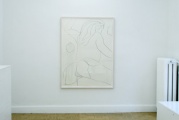Thomas Müllenbach - Torso, 17 January 2009 – 7 March 2009

Thomas Müllenbach
Torso 4, 2009
Graphite on paper
153x113cm (60.2x44.5in)
OPENING ON FRIDAY, JANUARY 16, 2009, 6 to 8 pm
Rotwand Gallery is proud to present large-scale drawings by Thomas Müllenbach for the first time in a solo exhibition.
Many have done it before him: Rodin, Klimt, Matisse and Picasso – they all have drawn female nudes with great dedication. Our present-day media are full to overflowing with the image of the naked woman. And now the Zurich artist, Thomas Müllenbach, has taken on this perilously seductive theme of “chercher la femme”.
His monumental drawings of reactor stations, cockpits and operation theaters, presented in 2007 at Kunsthaus Zürich, are now followed by just as large-scale depictions of the sumptuous bodies of women. Hard-to-imagine hi-tech areas are superseded by directly impressible body landscapes.
In his choice of means, nothing has changed. Thomas Müllenbach continues to avail himself of the graphite pencil, which he draws seamlessly across the large-format paper laid out on the floor of his studio. Because of the proximity between the drawing hand and the sheet of paper, between the body of the artist and the body of the image, a certain loss of control in the drawing act results; the artist’s gaze loses its way in his own drawing, leading to distortions and contractions and, in the end, to a new anatomy of the female body. Without crosshatching, shades or shadows, the graphite pencil outlines the pubic hair and labia, navel and breasts. Even the hot spots of swelling thighs and sensual curves do nothing to modify the stern expressiveness; a spare sensuousness is the result. The cropped materialization of the female body as a torso—the disavowal of feet, hands and face—‘anonymize’ the figures and, to the artist, make them compliant as objects. By thoroughly parsing the sexualized body, he alludes to the omnipresence of pornographic images. At the same time, he takes up the classical tradition of the torso and withstands the tension between reality and ideality.
He would not be Thomas Müllenbach if he didn’t succeed once again to minimize his ideas down to essential statements and to integrate them into his panoptical vision of “Das ganze Leben”. He would not be himself if he didn’t pursue his theme with ruthless verve, that is, with admiration for the linear beauty of the female body and, at the same time, with the subversive lust to expose it in all its cliché’s inflexibility.
Text by Angelika Affentranger-Kirchrath








